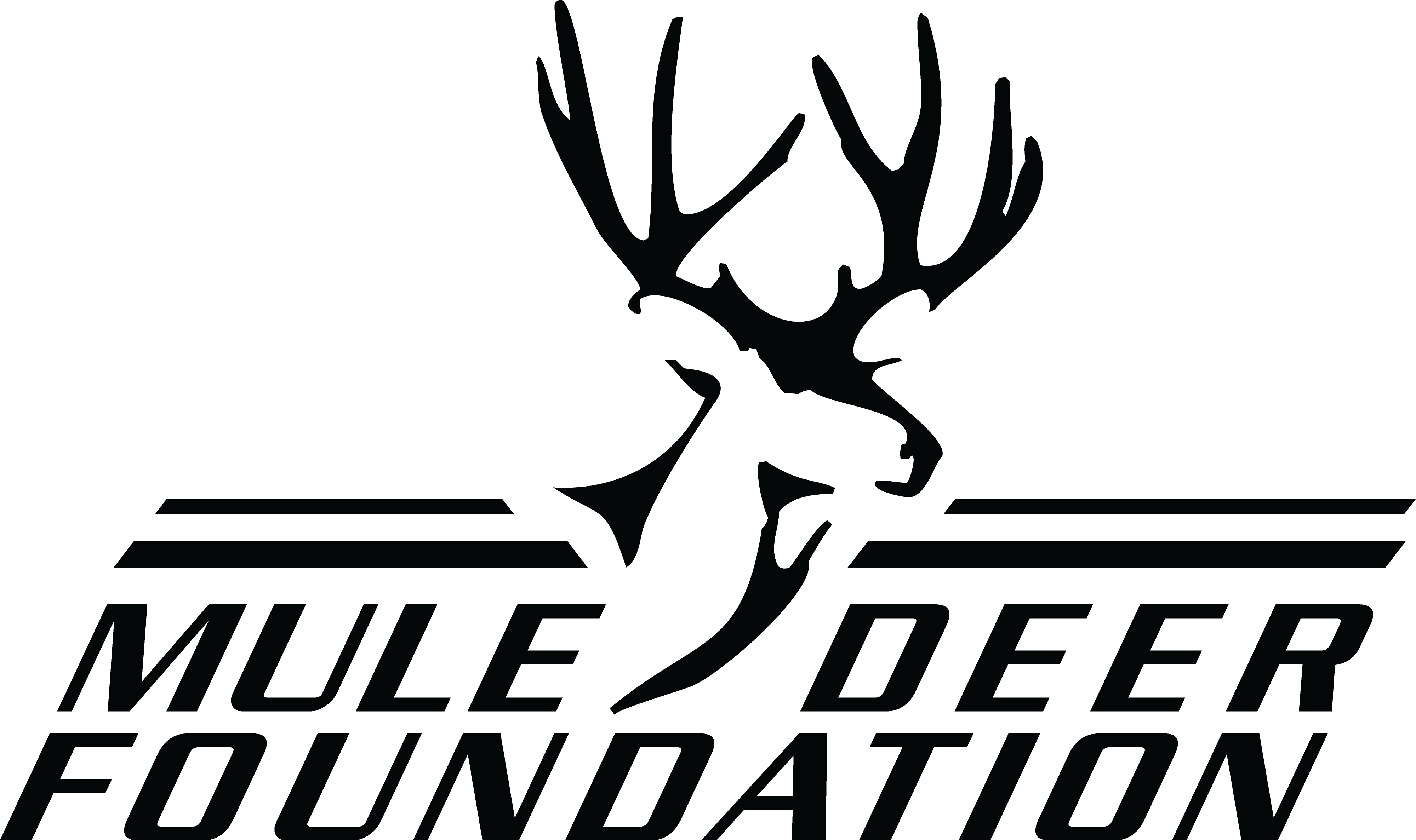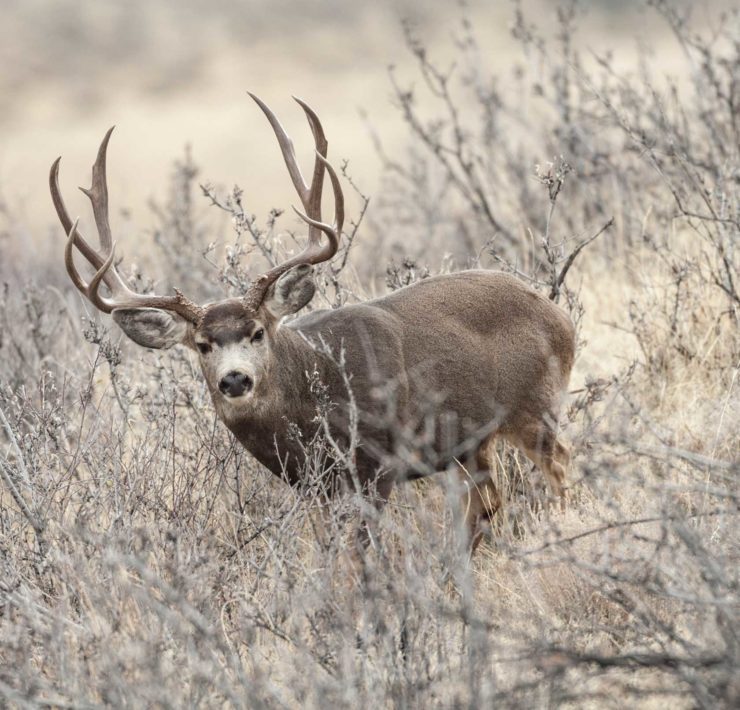Western Wildlife Conservation By the Numbers
(First Published in B&C publication Fair Chase)
By: Greg Sheehan MDF/BDF CEO and President and Steve Belinda MDF/BDF Chief Conservation Officer
Over the last 25 years, a common assertion you often hear is that mule deer populations are in decline. But is this true? This question is frequently posed to us at the Mule Deer Foundation (MDF), and it represents a significant issue that our leadership actively addresses. So, what’s the reality? The answer is nuanced. In short, it depends.
The status of mule deer populations across their range cannot be distilled into a singular response. Some states report declines in specific mule deer populations, while others indicate stability or even increases in their numbers. Location matters, but so is the response to areas experiencing population declines. MDF addresses these declines through partnerships, prioritizing actions in needed areas, increasing funding for habitat projects, and focusing on actions that have proven effective and beneficial to deer. Focusing on projects that benefit deer habitat, MDF is turning treated acres into deer.
The 2024 Range wide Status of Black-tailed and Mule Deer report from the Western Association of Fish and Wildlife Agencies (WAF- WA) indicates that several states are witnessing declines while others are stable or increasing. However, interpreting this information as an overall stable population status is misleading. Wildlife conservation is complex, and simplistic scorecards fail to capture the local dynamics influencing herd populations. Therefore, it is imperative to remain actively engaged in maintaining and enhancing sustainable, hunt able mule deer populations across all states.
The health of mule deer herds is influenced by various local factors, including habitat conditions, habitat availability and abundance, predation rates, drought, disease, development, and others. It’s not uncommon for adjacent herds to experience significant variations in population dynamics. Among these factors, the condition and availability of habitat are of utmost concern to MDF, and focusing on habitat is where we can effect positive change through targeted actions and have more deer on the landscape.
One factor that no one can predict and has a considerable influence on deer populations is weather, particularly winter conditions and prolonged drought. The winter of 2023-2024 drew attention to the severe impacts of harsh weather on mule deer populations in southwestern Wyoming, south- eastern Idaho, and northeastern Utah, where thousands of animals perished. These regions account for a substantial portion of each state’s overall mule deer population, but attributing the same level of loss to the entire state would be inaccurate. Similarly, eastern Montana has battled extreme prolonged drought in recent years and populations have been negatively influenced. However, deeming Montana’s mule deer population as declining based solely on this factor would oversimplify the issue. Such complexities exist in every state, where local populations have experienced significant losses, recent increases, or relative stability over decades.
Turning Acres into Deer
MDF collaborates with partners like state wildlife agencies, federal land management agencies, private landowners, and other stakehold- ers to tackle local and regional population challenges. Our main focus is habitat management, as we operate without land ownership and rely on partnerships to be effective. Our approach relies on identifying, assessing, and prioritizing opportunities for action, as well as evaluating funding availability, and prioritizing limited resources, allocating them to local mule deer populations that need them the most.
Our targeted efforts use a place-based strategy called the Priority Herds & Landscapes Initiative (PHL). PHL synthesizes scientific data and anecdotal evidence—including areas prioritized by hunters and MDF members, funding opportunities, and the effects of recent habitat-altering events—to guide our actions. We categorize this information down to 5th Level Hydraulic Unit Code, commonly referred to as watersheds (40,000 to 250,000 acres), ranking them from high (most needing help) to low. When opportunities or fund- ing arise, we can quickly coordinate with partners to implement projects that address identified needs by selecting high or medium watersheds and drilling down into the data to determine which activity could have the most beneficial impact and provide the highest likelihood of the habitat to produce more deer after project completion.
Historically, MDF has concentrated on public land managed by agencies, specifically the U.S. Forest Service (USFS) and Bureau of Land Management (BLM). With a recent influx of federal funding to address wildfire and land management issues through the Bipartisan Infrastructure Law and Inflation Reduction Act, we have intensified our efforts. By partnering with the USFS and BLM, MDF has developed agreements to fund projects that restore, enhance, and protect habitat across tens of thousands of acres in grasslands, rangelands, and forests. Utilizing our PHL model, we have directed resources to areas where mule deer habitat needs align with federal agency priorities and where deer can benefit the most. In 2024, with these enhanced efforts, we positively impacted an additional 70,000 acres of priority mule deer habitat.

Volunteers rebuilding fencing to wildlife-friendly standards. Fencing can be barriers to movement, imped migrations, and cause injury/death to deer and other wildlife. Designing or retrofitting fences in areas where animals cross is an extremely beneficial activity particularly in migration corridors.
Your Federal Dollars at Work!
Recently, MDF also began a Private Lands Initiative in the Great Plains, working directly with land- owners to improve habitat conditions, enhance animal migration corridors, and increase water avail- ability. These improvements benefit mule deer and support the interests of private landowners in livestock management while enabling us to access Farm Bill conservation funding. By broadening our focus to include private lands, the MDF can effectively address habitat and population needs across various land ownerships. We plan to extend our work into Tribal lands soon.
In 2018, during the MDF-sponsored Western Hunting and Conservation Expo, the Secretary of Interior Ryan Zinke signed Secretarial Order 3362 (SO3362), which aims to enhance winter ranges and migration corridors for mule deer, prong- horn, and elk in 11 western states. SO3362 allowed MDF to collaborate with federal and state agencies to prioritize projects in winter ranges and migration corridors identified by state agency wildlife departments. MDF secured funding to implement the order through a grant from the National Fish and Wildlife Foundation and increased our capacity, enabling us to assist partners in several western states in project implementation. Guided by the priorities outlined in SO3362 state action plans, MDF has secured over $5 million to restore habitat in winter range and migration corridors by enhancing vegetation, removing obstacles, and improving migratory success. To date, we have restored and enhanced thousands of acres of critical habitat and assisted in funding numerous highway crossing structures.
Winter ranges are vital for mule deer in many states and have been severely impacted bycatastrophic wildfires in recent years. MDF has led efforts to plant over 1.5 million shrubs—primarily sagebrush—across key winter habitats used by mule deer, elk, pronghorn, and sage grouse. The restoration work we’ve initiated accelerates habitat recovery in regions where natural rehabilitation could take decades. Additionally, we focus on protecting intact winter ranges by targeting invasive grasses through selective herbicides that do not harm native plant species, thereby reducing the risk of fire and enabling the re-establishment of native flora.
In Idaho’s portion of the Great Basin, in partnership with the Idaho Department of Fish and Game and BLM, MDF has successfully restored over 50,000 acres of burned winter range and treated over 30,000 acres affected by invasive grasses. By utilizing PHL and collaborating with federal and state agencies, private landowners, and other stakeholders, we are concentrating our efforts on regions that will yield significant improvements in mule deer habitat. This will ensure sustainability for current populations and foster growth in those in decline.
Volunteers building a water distribution system in Arizona. Water is life in many southwestern states. By increasing the availability of water and ensuring it is flowing in the dry season can sustain local deer populations.
Large, catastrophic wildfires like the one shown here in western Colorado, are impacting hundreds of thousands of acres of deer habitat every year. Work to prevent these large fires and quick action after these fires to restore habitat is a fundamental part of MDF’s work. Preventing noxious weeds,replanting vegetation particularly shrubs, and replacing fencing to be able to adequately manage post-fire grazing are key.
Northern California and parts of Oregon have also been ravaged by wildfires in beetle-killed, particularly in forested areas that provide essential sum- mer and transitional ranges for mule deer. MDF has responded with numerous projects focused on the accelerated restoration of key deer habitats. MDF works closely with the USFS and private timber owners to restore these affected lands and prevent future destructive fires. This includes pre-commercial and commercial treatments to improve forest health, enhance forage availability, and promote quicker growth of remaining trees by reducing density. In burned areas, we also work on reforestation by clearing debris to prepare lands to facilitate new tree and shrub plantings. Additionally, we employ mastication to mitigate fire threats from flammable shrubs, recycle invasive tree species, and contribute nutrients back into the ecosystem. This can improve migration success by easing movements and creating travel corridors.
MDF also enhances habitats in aspen and mountain shrub communities and expands water sources through projects that establish guzzlers, ponds, wells, and pipelines where they are most needed. Enhancing riparian and mesic areas to boost water retention improves overall water quality and availability while accompanying fencing and grazing adjustments work to increase habitat capacity.
Since 2020, MDF has completed or significantly funded over 650 projects, resulting in approximately 1 million acres of total conservation benefit to mule deer, black- tailed deer, and other wildlife. Conservatively, if our efforts have a 1–2 percent net beneficial impact in sustaining or increasing local deer populations, our efforts have contributed to 10,000–20,000 deer. This conversion factor shows how MDF turns acres of habitat and miles of fencing into numbers of deer on the landscape and shows why habitat projects matter and why MDF focuses on such actions. On a policy level, MDF actively champions federal and state initiatives that significantly impact mule deer and other big-game species, particularly those that fund habitat projects and allow for effective use of available dollars. We advocate for policies that enhance migration corridors, winter ranges, funding opportunities, and streamlining restoration activities on public lands. We led efforts to secure a categorical exclusion for mule deer and sage-grouse habitats under the 2018 Farm Bill. Conversely, we confront policy challenges that threaten mule deer hunting.
In 2024, Colorado’s Proposition 127 aimed to ban hunting for various cats, which could lead to future restrictions on big-game hunting. However, through collaboration with sportsman coalitions, we successfully defeated this proposition. We anticipate ongoing threats from state-level initiatives and will re- main vigilant in representing sportsmen’s interests in safeguard- ing mule deer and wildlife management.
Overall, the status of mule deer across their range is highly variable and subject to continual fluctuations based on several influencing factors. In our mission to enhance habitats to support current and growing populations, MDF employs a strategic and proven approach based on science, partnerships, and prioritizing efforts that foster the sustainability of local herds and help grow more deer by increasing the number of deer that habitat can support. MDF also remains focused on fulfilling its mission—to ensure the conservation of mule deer, black-tailed deer, and their habitats—by turning acres of habitat projects into deer on the landscape.
Thanks for reading!
As always, Good luck this winter and remember to send any success pictures or stories from the field to [email protected] and you could be featured on our website or in our magazine. If this article or any of our articles have helped you become a better hunter or conservation steward, consider becoming a member of the Mule Deer Foundation or the Blacktail Deer Foundation or both. Click here to join: https://muledeer.org/product-category/membership/ or https://www.blacktaildeer.org/





